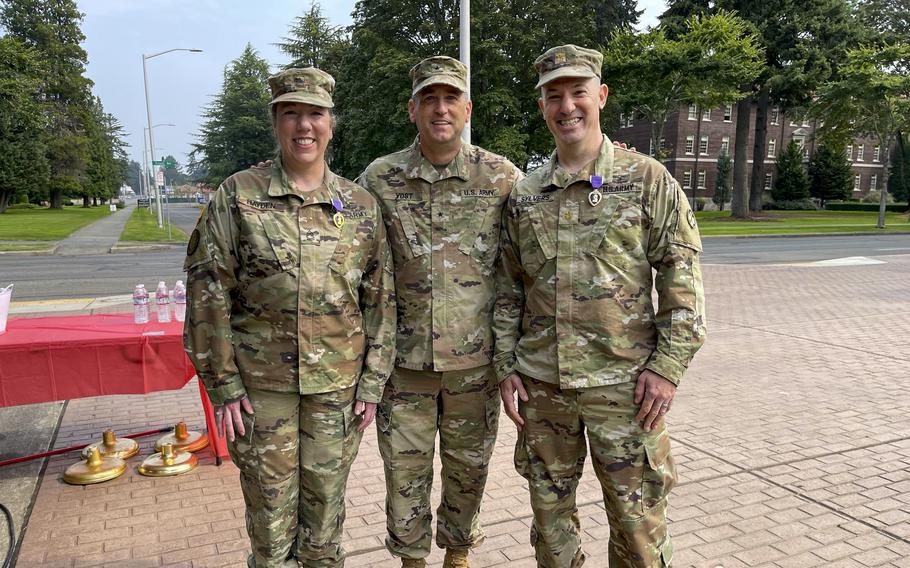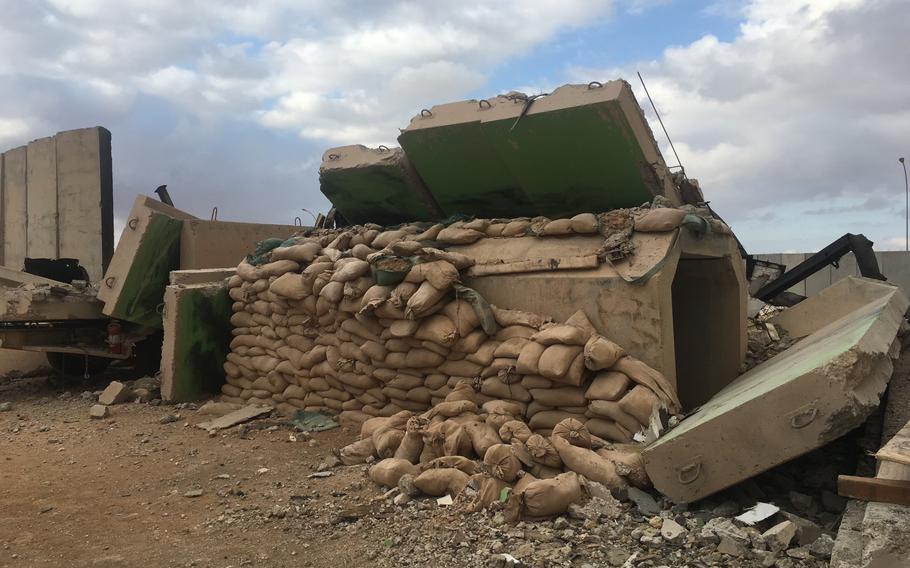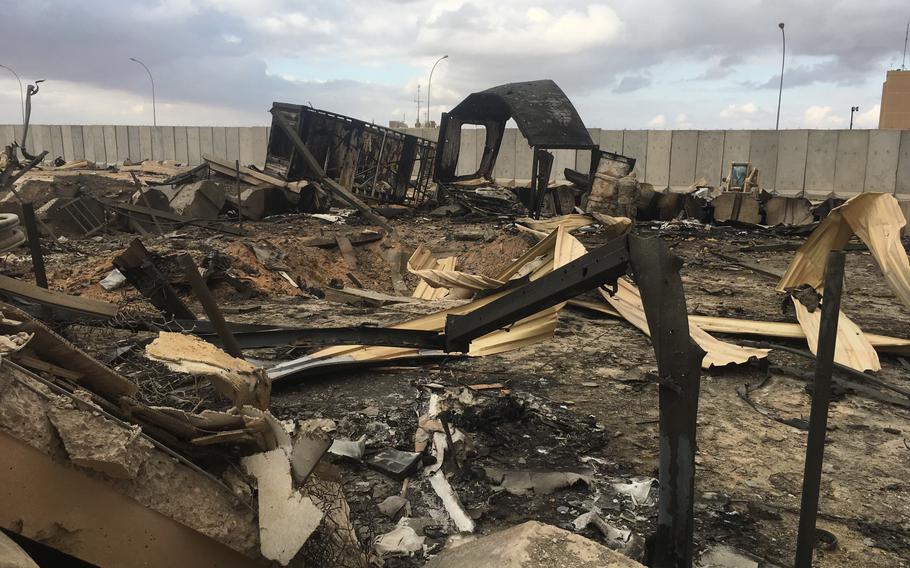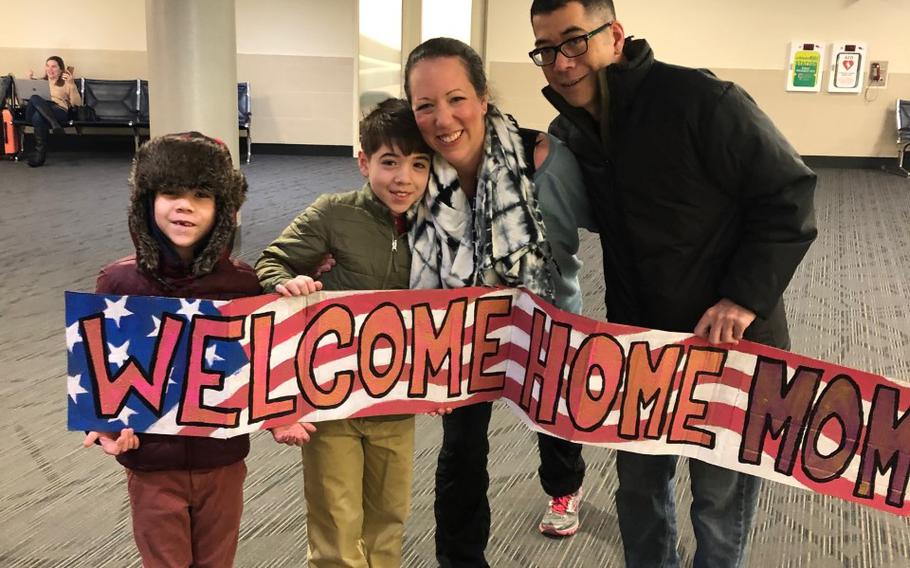
Army Sgt. 1st Class Andrea Hayden, left, and retired Maj. Patrick Sylvers, right, receive the Purple Heart on Sept. 11, 2022, at Joint Base Lewis-McChord, Wash., after surviving a missile attack on al Asad Air Base in Iraq in 2020. (Ronald Bell/U.S. Army)
Bad memories return to Army Sgt. 1st Class Andrea Hayden during the first week of the year, resurrecting the 2020 missile barrage on an Iraqi air base that almost ended her life.
Three years ago Sunday, Iranian ballistic missiles bombarded some 1,000 troops at al Asad Air Base, approximately 100 miles west of Baghdad.
No U.S. troops died in the attack, but for the more than 100 of them who would be diagnosed with traumatic brain injuries, the impact lingers.
Hayden and another survivor of the attack, Patrick Sylvers, gave a series of interviews in which they talked about living with traumatic brain injuries.

A bunker at al Asad Air Base in Iraq protected Army Sgt. 1st Class Andrea Hayden and Maj. Patrick Sylvers during an Iranian missile attack Jan. 8, 2020. (Patrick Sylvers)
“I got really depressed the first year because I felt like all the stuff that I worked for was gone,” Sylvers said. “That was the only time in my life I thought about suicide.”
He recalled having thoughts at the time of “’I can’t do anything anymore, I’m failing at everything I do,’ and I’m not used to that.”
The repercussions also were significant for Hayden, who continues to struggle with her balance, often getting panic-inducing feelings of vertigo.
“It definitely affected my short-term memory,” she said of the attack. “It took me probably a year to be able to have a normal conversation. I would forget what I was saying, like halfway through saying it.”
When they wanted to avoid talking about especially painful topics in the interviews, they referred to their quotes in an Army statement last fall, when the two received Purple Hearts at Joint Base Lewis-McChord, Wash.
Three years ago, Hayden served as a behavioral health specialist deployed to al Asad. She was part of a two-person team with Sylvers, a major and an Army psychologist.
Both were assigned to the 1972nd Medical Detachment (Combat and Operational Stress Control), an Army Reserve unit based at Lewis-McChord.
On Jan. 7, 2020, Hayden and Sylvers were supposed to fly out from al Asad to join the rest of their unit in Kuwait for the trip home.

Some 11 missiles, measuring about 40 feet long and carrying 1,600-pound warheads, struck Iraq's al Asad Air Base in a January 2020 attack, leaving impact craters up to 30 feet wide. (Patrick Sylvers)
Troops on base received warnings to prepare for an attack by 11 p.m., Hayden and Sylvers recalled. The bunkers filled early that evening, Hayden said.
But by midnight, no strikes had come and troops grew restless. Some began leaving the bunkers, she recalled.
The missiles hit around 1:34 a.m., CNN reported in 2020. When the barrage began, Sylvers was outside his bunker. The 47-year-old remembers the people in the bunker saying they would close the door if they didn’t hurry, so he ran inside.
Hayden said she couldn’t see anything in the pitch-black darkness of the bunker. But the impact of the missiles smashing into the ground felt like an earthquake, she said.
The troops stumbled out of their bunkers at dawn. Some 11 missiles, measuring about 40 feet long and carrying 1,600-pound warheads, had struck the base, The Washington Post reported. The impact left craters up to 30 feet wide.
Sylvers recalls the extensive damage, including seeing half of a helicopter burning in the middle of a street.
Hayden emerged from the bunker and asked someone for a cigarette. She remembers calling her family to tell them she was still alive and using a shattered bathroom that offered no privacy.

Army Sgt. 1st Class Andrea Hayden adopted a terrier named Ruby on the first anniversary of the Iranian missile attack on al Asad Air Base in Iraq, which occurred Jan. 8, 2020. (Andrea Hayden)
The two found their vehicle in the parking lot, somehow undamaged. They got it running and like many others at the base, they went back to work.
Pentagon officials emphasized that no service members had died in the barrage. A few days afterward, then-President Donald Trump said at a news conference that a few soldiers had headaches but not “very serious injuries,” a New York Times report said.
That statement drew criticism from veterans advocates. Paul Rieckhoff, the founder of Iraq and Afghanistan Veterans of America, said at the time that the comments downplayed the severity of traumatic brain injuries.
TBI has been called one of the signature injuries of 20 years of war. The Pentagon says it’s tracking 463,392 cases since 2000, according to the latest numbers from Aug. 10, 2022.
Troops at the base began showing symptoms of TBI over the next few days, Hayden and Sylvers said. The pair debriefed fellow survivors of the attack, sitting down and talking with them about what they were feeling.
Hayden recalls the dazed expression she saw on everyone’s faces in those days, how their eyes seemed bigger than normal.
She herself began feeling strangely, forgetting the names of people she had known for months. Sylvers remembers feeling like he needed to fight someone, his body tensing up.
The two flew into Kuwait after four days, the Army statement on the pair in September said.

Army Sgt. 1st Class Andrea Hayden reunites with her sons Samuel and Peter and husband, Daichi, on Jan. 30, 2020, after finishing a deployment that saw her survive an Iranian missile barrage. (Andrea Hayden)
When they arrived at the base’s hospital for an evaluation, detachment sergeant Master Sgt. David Cantu examined them. He said it was evident that the two needed medical attention.
“These were not the same soldiers we sent forward,” Cantu recalled in the Army statement.
After leaving the hospital in Kuwait, Hayden went for a walk, just to wind down. Then she began feeling dizzy, her heart racing. She needed to sit down on the side of the road.
“It was pretty obvious that something was not the way it should be,” she said.
The three years since the attack have proved mentally and physically challenging for Sylvers and Hayden. Sylvers said he doesn’t remember much from the year after the attack.
“The first year is kind of a whirlwind,” he said.
But he does remember the chronic migraines, double vision and changes in his mood, appetite and sleep.
He had to quit his job at a Veterans Affairs primary care mental health unit and he lost a tenure-track teaching position at the University of Washington.
Sylvers had helped troops and veterans with their mental health, but he found himself unwilling to accept help from others.
Both of them said their therapy has helped them manage their conditions.
Sylvers medically retired from the Army Reserve in 2021. He got special glasses from Joint Base Lewis–McChord that help him with his vision.
He now works at a center that provides counseling to veterans with TBI and post-traumatic stress disorder. Sylvers said his experiences have allowed him to connect more deeply with the veterans he’s helping.
On Sept. 11 last year, Sylvers reunited with Hayden, now 40, at the Purple Heart ceremony at Joint Base Lewis-McChord.
The two have texted each other since the attack for support, but the ceremony marked the first time they had met since coming home from their deployments.
Hayden now works from home as a data administrator for a utility company and still serves in the Army Reserve. On the first anniversary of the attack, she adopted a 4-year-old terrier named Ruby.
“That was a silver lining,” Hayden said. “It’s always good to remember that day as a good day, because I got her.”